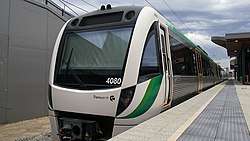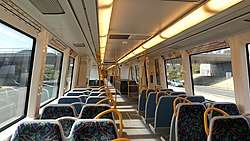Transperth B-series train
The B-series trains are a class of electric multiple unit built by Downer Rail, Maryborough for Transperth between 2004 and 2019.
| Transperth B-series | |
|---|---|
 B-series 80 at Optus Stadium Station | |
 The interior of B-series 76 | |
| In service | 2004–present |
| Manufacturer | Downer Rail/Bombardier |
| Built at | Maryborough |
| Entered service | 2004-2019 |
| Number under construction | 0 (construction & delivery complete as of April 2019) |
| Number in service | 78 3-car sets (July 2019) |
| Formation | 3 carriage sets may be coupled to form either a 6, 9 or 12 car set |
| Fleet numbers | 049-126 (BEA 4049- BEA 4126, BET 6049- BET 6126, BEB 5049- BEB 5126) |
| Capacity | 600 (standing 3-car) 1,200 (standing 6-car) |
| Operator(s) | Transperth |
| Depot(s) | Nowergup, Mandurah, Claisebrook |
| Line(s) served | Armadale/Thornlie, Fremantle, (future) Forrestfield–Airport Link, Joondalup, Mandurah, Midland and (proposed) Morley–Ellenbrook lines |
| Specifications | |
| Train length | 73 m (239 ft 6 in) |
| Width | 2.9 m (9 ft 6 in) |
| Height | 3.1 m (10 ft 2 in) |
| Maximum speed | 130 km/h (81 mph) (160 km/h (99 mph) design) |
| Weight | 120 t (120 long tons; 130 short tons) |
| Traction system | Bombardier MITRAC Traction system with IGBT inverters powering 8 AC Traction Motors per 3-car set (Bo-Bo, 2-2, Bo-Bo) |
| Electric system(s) | 25 kV AC overhead lines |
| Current collection method | Pantograph |
| Braking system(s) | Microprocessor controlled blended pneumatic & regenerative dynamic |
| Track gauge | 1,067 mm (3 ft 6 in) |
History
Perth's first electrified trains, the two-carriage A-Series, entered service in September 1991. The new three-carriage B-series were introduced on 4 October 2004 as part of the New MetroRail project. Thirty-one B-series sets were purchased to operate on the new Joondalup and Mandurah lines. They are mainly based at Nowergup depot but are occasionally stored at Claisebrook Depot.
The B-series trains are cleared to operate on the Midland, Armadale/Thornlie and Fremantle lines and are regularly used on these lines alongside the older A-Series. However, not all stations on these lines are capable of handling six-car sets as the platforms are not long enough, so they are usually run as 3-car sets. There are reported problems with the acceleration/deceleration systems with the closely spaced stations. Platforms at the original stations on the Joondalup line had to be lengthened to accommodate the six-car trains, as did Platform 1 at Showgrounds and both platforms at West Leederville. The Mandurah line stations, along with Butler, Clarkson, Currambine and Greenwood on the Joondalup line, and the rebuilt Kelmscott station on the Armadale line were built with longer platforms.
Additional sets
In 2006, the Public Transport Authority ordered a second batch of 15 three-carriage B-series trains from Bombardier/EDI Rail to increase capacity on the Joondalup and Mandurah lines.[1] The first entered service on 28 June 2009. These sets feature an upgraded communication system and brighter destination screens than the original B-series sets.
Funding for a third batch of 15 sets was announced by the Government of Western Australia in the 2011/12 State Budget.[2] The order was increased by two sets in August 2012 to service the planned Aubin Grove station, followed by a further five sets in November 2012.[3][4][5][6] Funding for an additional 10 sets was announced in the May 2016 state budget with delivery planned for 2018-20 these sets will provide additional capacity on the existing network as well as service the Forrestfield–Airport Link when it opens in 2021. The B series fleet will total 78 3-carriage sets. As of April 2019 all 78 3-car sets have been delivered with 78 3-car sets in service[7]
Accidents
Accident at Nowergup Depot
On 23 August 2006 at approximately 18:00, two B-series trains (sets BEA 053 and BEB 060) were involved in a head-on collision at Nowergup depot. Cars from both sets were damaged badly enough to be sent back to builders EDI's facility in Maryborough for repair. During these repairs, undamaged cars from both sets were re-formed into set 60, which then returned to service. The damaged cars were fixed and returned to service (as set 60) in time for the opening of the Mandurah line in December 2007.
Additional accessories
Since early-2016, B-series sets 115 and onwards have been fitted with USB charging ports as part of a 6-month trial.[8] They are located below the emergency door release and aside from the intercarriage gangways. A free Wi-Fi trial was conducted in late 2018 to early 2019 on B-Series sets 105 and 111, as well as Perth Underground and Elizabeth Quay stations. Free Wi-Fi trials were also conducted on two high-traffic buses in the Perth CBD.
See also
References
- "WA Government secures new railcars". Retrieved 22 October 2009.
- "State Budget 2011-12: Building the State - Funding for new railcars for Perth's growing transport system". Retrieved 22 August 2012.
- "More rail cars for Perth transport system". Retrieved 7 November 2012.
- More new railcars for Perth Archived 22 February 2014 at the Wayback Machine Railway Express 14 November 2012
- Perth grapples with growth and funding challenges International Railway Journal 6 November 2013
- "Rolling Stock contracts and deliveries" Railway Digest December 2014 p. 47
- More EMUs for Perth Railway Gazette International 23 June 2016
- https://thewest.com.au/news/australia/transperth-gives-power-to-commuters-ng-ya-137234
Bibliography
- May, Andrew S; Gray, Bill (2006). A History of WAGR Passenger Carriages. Midland, WA: Bill Gray. ISBN 0646459023.
External links
![]()